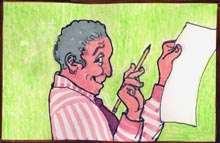No products in the cart.
The White Bread Years

In the Absence of Multigrain
By Steve Carr
I grew up eating white bread. What kid from the 1960s, living in eastern Idaho in a house with a two-car garage and a half-acre of lawn, didn’t love our basic, soft, thinly sliced bread? Never mind that it claimed to be wholesome in at least twelve different ways. To us, it felt right wrapped around our PB and Js. Besides, it was all we knew.
We took sack lunches to school. On our twenty-minute lunch break, my friends and I would produce our brown paper bags, anticipating the goodies our moms might have put together for us. It’s not like there were many surprises. Still, with the flourishes of magicians, we’d pull out an apple or banana, a few chips (occasionally, embarrassingly, still in their original family-sized bags, rolled down to the salty, finger-nail-sized dregs) and a sandwich. Pretty much always my sandwich consisted of peanut butter and jelly between palate-sticking bread slices. If Mom was short on jelly, I often got only a gob of peanut butter. Together with the bread, this made swallowing, not to mention talking, a fun addition to our prepubescent-boys idea of humor. My friend, whose dad was a sheep rancher, would pull out a sandwich that had been lovingly prepared with the same white bread. But his bread would be wrapped around a thin slice of mutton. It may have been garnished with a bit of butter, although not necessarily. Being broadminded, we’d occasionally trade sandwiches. Truth is, he’d mostly ask if I wanted to trade and I’d mostly say, “Maybe tomorrow.”
The turbulent ’60s weren’t too turbulent for eight-year-olds in eastern Idaho. Mrs. Weekly, our second-grade teacher, always wore an “I Dream of Jeannie” hairdo, cat-eye glasses, and a dress. We played tag at recess and rode yellow buses home. No one’s parents picked them up from school unless they were going to the dentist and no one rode a special bus across town to a neighborhood demographically different from our own. Walter Cronkite was on TV for thirty minutes every night, which felt like an eternity. I do recall seeing the pin-on buttons at the Eastern Idaho State Fair that rather titillatingly suggested we, “Make Love, Not War.” But our gang was more interested in the booth that had water running from a magic spigot floating in thin air.
Did we play sandlot baseball and ride our Stingray bicycles to the Saturday John Wayne matinees, leaving the bikes in a pile, without locks, in front of the theater? Yes. Were we safe and ignorant and homogenous and unsupervised for hours at a time? Yes.
Today my world view is broader. I’ve discovered that what I’m told by media pundits, amateur hacks, and even neighbors doesn’t always jibe with what I’ve witnessed with my own eyes at home and in places far from home. I prefer multigrain bread these days. The nuance of the flavors, not to mention the nutritious ingredients, both please my palate and help me feel better.
Would I change anything from my sheltered, privileged childhood? No. I have to say it was pretty idyllic. The transition from white bread to multi-grain has come incrementally. There’s no putting “I Dream of Jeannie” back in the bottle—nor would I want to. Yet I hang on to the bottle. Is that a disconnect? Probably. Kind of like the magic spigot, endlessly dispensing fresh water from no apparent source.
This content is available for purchase. Please select from available options.
Register & Purchase Purchase Only
Register & Purchase Purchase Only

